University Assignment: Global Supply Chain Management of Coca-Cola
VerifiedAdded on 2023/01/16
|17
|5247
|1
Report
AI Summary
This report critically analyzes the global supply chain management of Coca-Cola, a leading FTSE-100 organization. The analysis identifies key contemporary problems and challenges, including low-calorie cola performance, competition in emerging markets, and the need for digital marketing evolution. The report then examines how Coca-Cola manages its supply chain, highlighting its collaborative approach, use of real-time data, and investment in digitalization. It also discusses strategies like segmented revenue growth, focus on emerging markets, and the use of the HAPTIC model. The analysis covers issues such as inventory management, supplier relations, and maintaining quality and safety. The report also reflects on current global Supply Chain Management best theories and practices, and how Coca-Cola addresses the challenges it faces through its supply chain and logistics operations. The report concludes with an overview of Coca-Cola's strategies to address digital woes and to drive revenue and profit growth. It discusses how Coca-Cola follows the relationship matrix in its supply chain for supplying its products and services worldwide.
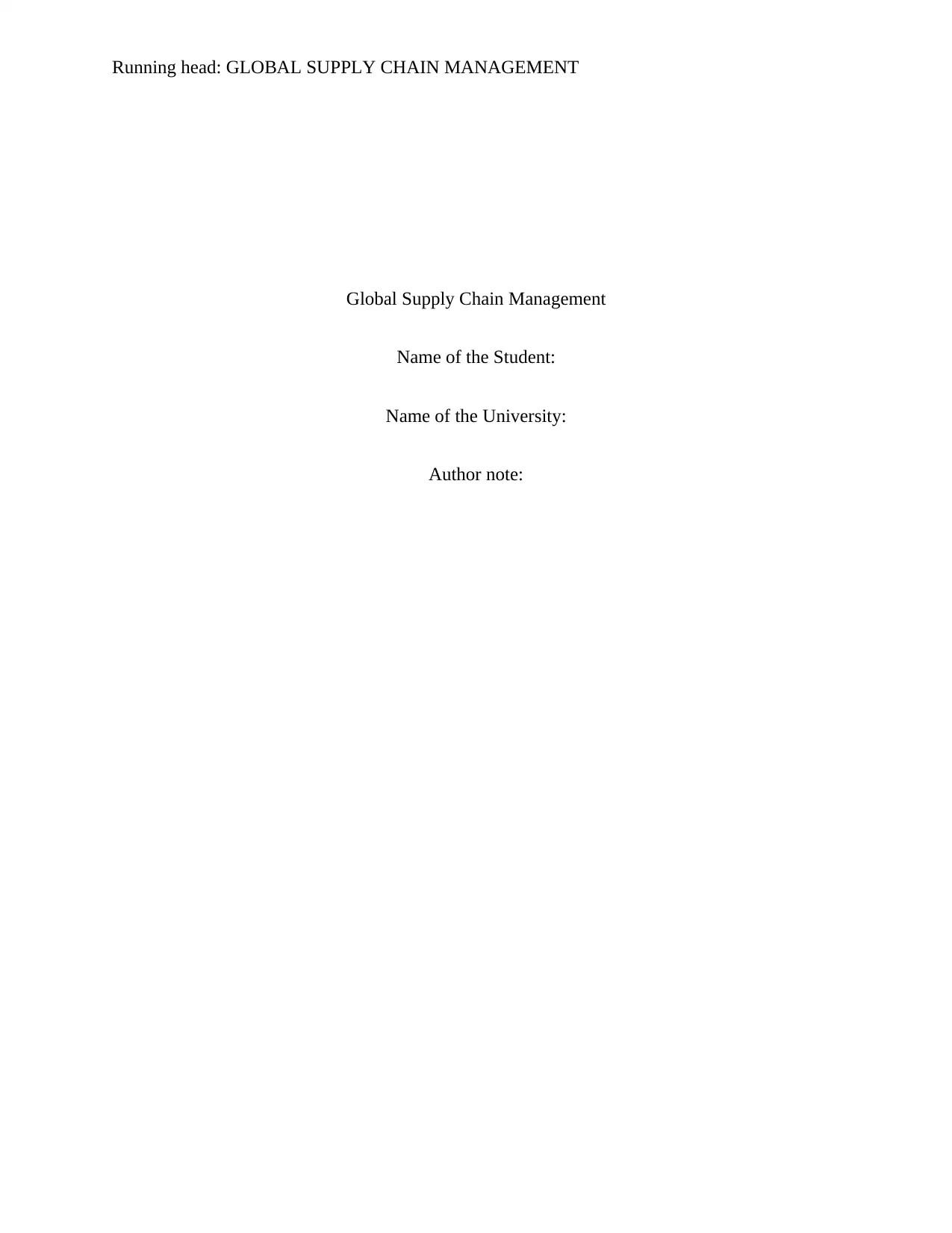
Running head: GLOBAL SUPPLY CHAIN MANAGEMENT
Global Supply Chain Management
Name of the Student:
Name of the University:
Author note:
Global Supply Chain Management
Name of the Student:
Name of the University:
Author note:
Paraphrase This Document
Need a fresh take? Get an instant paraphrase of this document with our AI Paraphraser
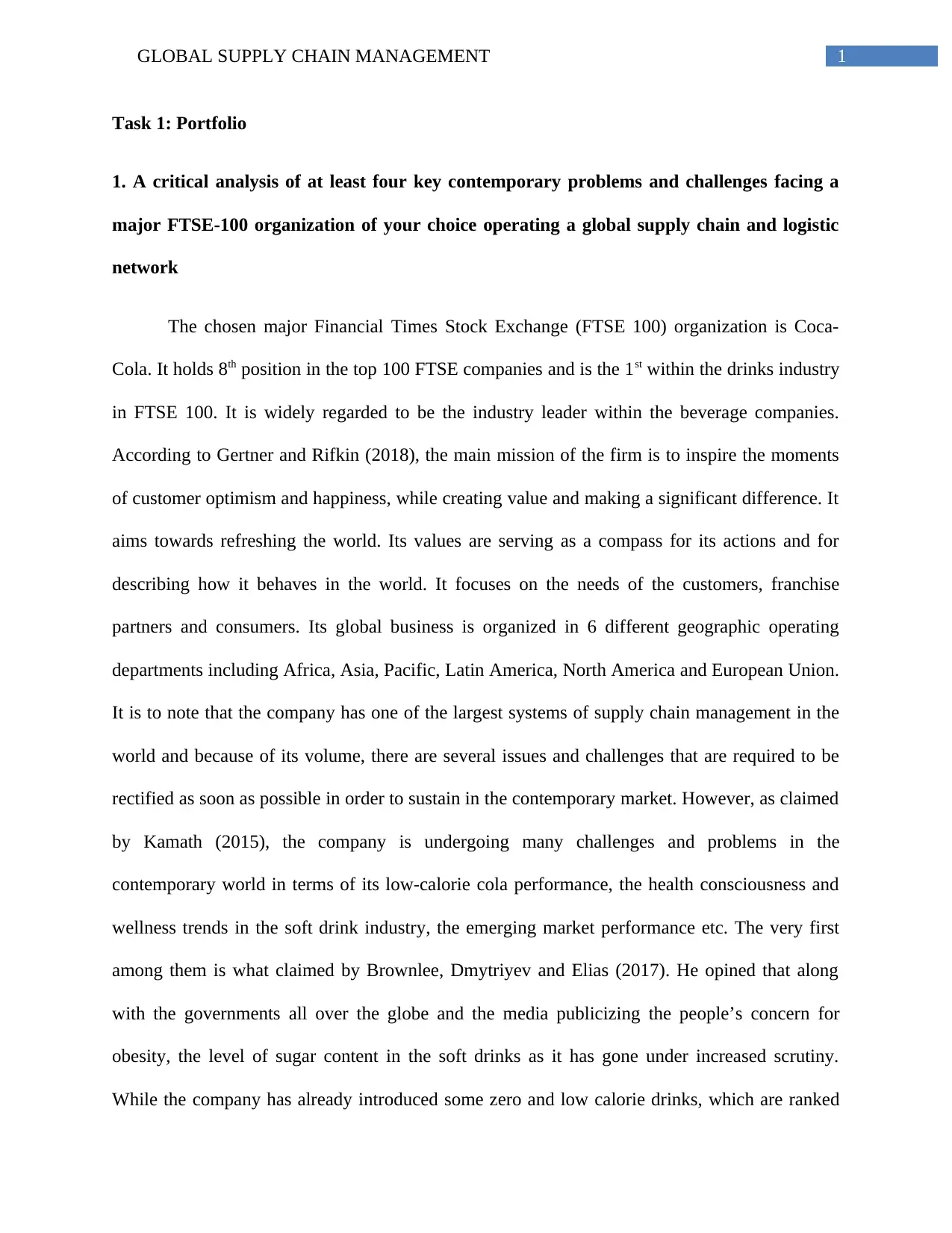
1GLOBAL SUPPLY CHAIN MANAGEMENT
Task 1: Portfolio
1. A critical analysis of at least four key contemporary problems and challenges facing a
major FTSE-100 organization of your choice operating a global supply chain and logistic
network
The chosen major Financial Times Stock Exchange (FTSE 100) organization is Coca-
Cola. It holds 8th position in the top 100 FTSE companies and is the 1st within the drinks industry
in FTSE 100. It is widely regarded to be the industry leader within the beverage companies.
According to Gertner and Rifkin (2018), the main mission of the firm is to inspire the moments
of customer optimism and happiness, while creating value and making a significant difference. It
aims towards refreshing the world. Its values are serving as a compass for its actions and for
describing how it behaves in the world. It focuses on the needs of the customers, franchise
partners and consumers. Its global business is organized in 6 different geographic operating
departments including Africa, Asia, Pacific, Latin America, North America and European Union.
It is to note that the company has one of the largest systems of supply chain management in the
world and because of its volume, there are several issues and challenges that are required to be
rectified as soon as possible in order to sustain in the contemporary market. However, as claimed
by Kamath (2015), the company is undergoing many challenges and problems in the
contemporary world in terms of its low-calorie cola performance, the health consciousness and
wellness trends in the soft drink industry, the emerging market performance etc. The very first
among them is what claimed by Brownlee, Dmytriyev and Elias (2017). He opined that along
with the governments all over the globe and the media publicizing the people’s concern for
obesity, the level of sugar content in the soft drinks as it has gone under increased scrutiny.
While the company has already introduced some zero and low calorie drinks, which are ranked
Task 1: Portfolio
1. A critical analysis of at least four key contemporary problems and challenges facing a
major FTSE-100 organization of your choice operating a global supply chain and logistic
network
The chosen major Financial Times Stock Exchange (FTSE 100) organization is Coca-
Cola. It holds 8th position in the top 100 FTSE companies and is the 1st within the drinks industry
in FTSE 100. It is widely regarded to be the industry leader within the beverage companies.
According to Gertner and Rifkin (2018), the main mission of the firm is to inspire the moments
of customer optimism and happiness, while creating value and making a significant difference. It
aims towards refreshing the world. Its values are serving as a compass for its actions and for
describing how it behaves in the world. It focuses on the needs of the customers, franchise
partners and consumers. Its global business is organized in 6 different geographic operating
departments including Africa, Asia, Pacific, Latin America, North America and European Union.
It is to note that the company has one of the largest systems of supply chain management in the
world and because of its volume, there are several issues and challenges that are required to be
rectified as soon as possible in order to sustain in the contemporary market. However, as claimed
by Kamath (2015), the company is undergoing many challenges and problems in the
contemporary world in terms of its low-calorie cola performance, the health consciousness and
wellness trends in the soft drink industry, the emerging market performance etc. The very first
among them is what claimed by Brownlee, Dmytriyev and Elias (2017). He opined that along
with the governments all over the globe and the media publicizing the people’s concern for
obesity, the level of sugar content in the soft drinks as it has gone under increased scrutiny.
While the company has already introduced some zero and low calorie drinks, which are ranked

2GLOBAL SUPPLY CHAIN MANAGEMENT
top in the market within their own categories, still, the overall category is pale in the market of
United States and this reflects the concerns over the other alternative sweeteners. Secondly,
Grosse (2016) in this context have mentioned that while Coca Cola is dominating the emerging
markets, it has also increased the level of competition from the other domestic players. The other
global rivals of the company like Pepsi Co. is also seeking for growing in the regions where
Coca Cola is operating. Jones and Comfort (2018) has opined that if Coca Cola wants to hit its
2020 targets, it is very important for the company to ensure its BRIC growth and expansion of
the significant secondary markets such as Indonesia and Vietnam.
Furthermore, it is to note that Coca cola already has a good variety of juice brands and
waters under its portfolio, which have the potential to be the winners for the company. However,
in order to ensure this success, they need to continue developing and innovating their products
with respect to the health and wellness segments within its brands. One of the significant areas of
growth could be the energy and the functional drinks. According to Haines (2017), as the vogue
of the carbonates in the traditional high consumption markets has waned, the pressure from the
part of the public for reducing the consumption of sugar vat h soft drinks is likely to stay high.
The company is required to increase the sales of the other beverages and diversify its product
portfolio of soft drinks, comprising of both the dairy and the functional beverages. Fourthly, by
the own admission of Coke, television has remained its primary channel of advertising.
Notwithstanding this fact, with the ever increasing consumption of mobile phones and internet,
this approach needs to be evolved. Despite of having about 300 applications all around the
world, most of the applications of the applications have below 100,000 users. Hence, the
popularity of Coca-cola in the digital world is quite less in this contemporary world where
digitalization is the core of about each and every business, be it at or international.
top in the market within their own categories, still, the overall category is pale in the market of
United States and this reflects the concerns over the other alternative sweeteners. Secondly,
Grosse (2016) in this context have mentioned that while Coca Cola is dominating the emerging
markets, it has also increased the level of competition from the other domestic players. The other
global rivals of the company like Pepsi Co. is also seeking for growing in the regions where
Coca Cola is operating. Jones and Comfort (2018) has opined that if Coca Cola wants to hit its
2020 targets, it is very important for the company to ensure its BRIC growth and expansion of
the significant secondary markets such as Indonesia and Vietnam.
Furthermore, it is to note that Coca cola already has a good variety of juice brands and
waters under its portfolio, which have the potential to be the winners for the company. However,
in order to ensure this success, they need to continue developing and innovating their products
with respect to the health and wellness segments within its brands. One of the significant areas of
growth could be the energy and the functional drinks. According to Haines (2017), as the vogue
of the carbonates in the traditional high consumption markets has waned, the pressure from the
part of the public for reducing the consumption of sugar vat h soft drinks is likely to stay high.
The company is required to increase the sales of the other beverages and diversify its product
portfolio of soft drinks, comprising of both the dairy and the functional beverages. Fourthly, by
the own admission of Coke, television has remained its primary channel of advertising.
Notwithstanding this fact, with the ever increasing consumption of mobile phones and internet,
this approach needs to be evolved. Despite of having about 300 applications all around the
world, most of the applications of the applications have below 100,000 users. Hence, the
popularity of Coca-cola in the digital world is quite less in this contemporary world where
digitalization is the core of about each and every business, be it at or international.
⊘ This is a preview!⊘
Do you want full access?
Subscribe today to unlock all pages.

Trusted by 1+ million students worldwide
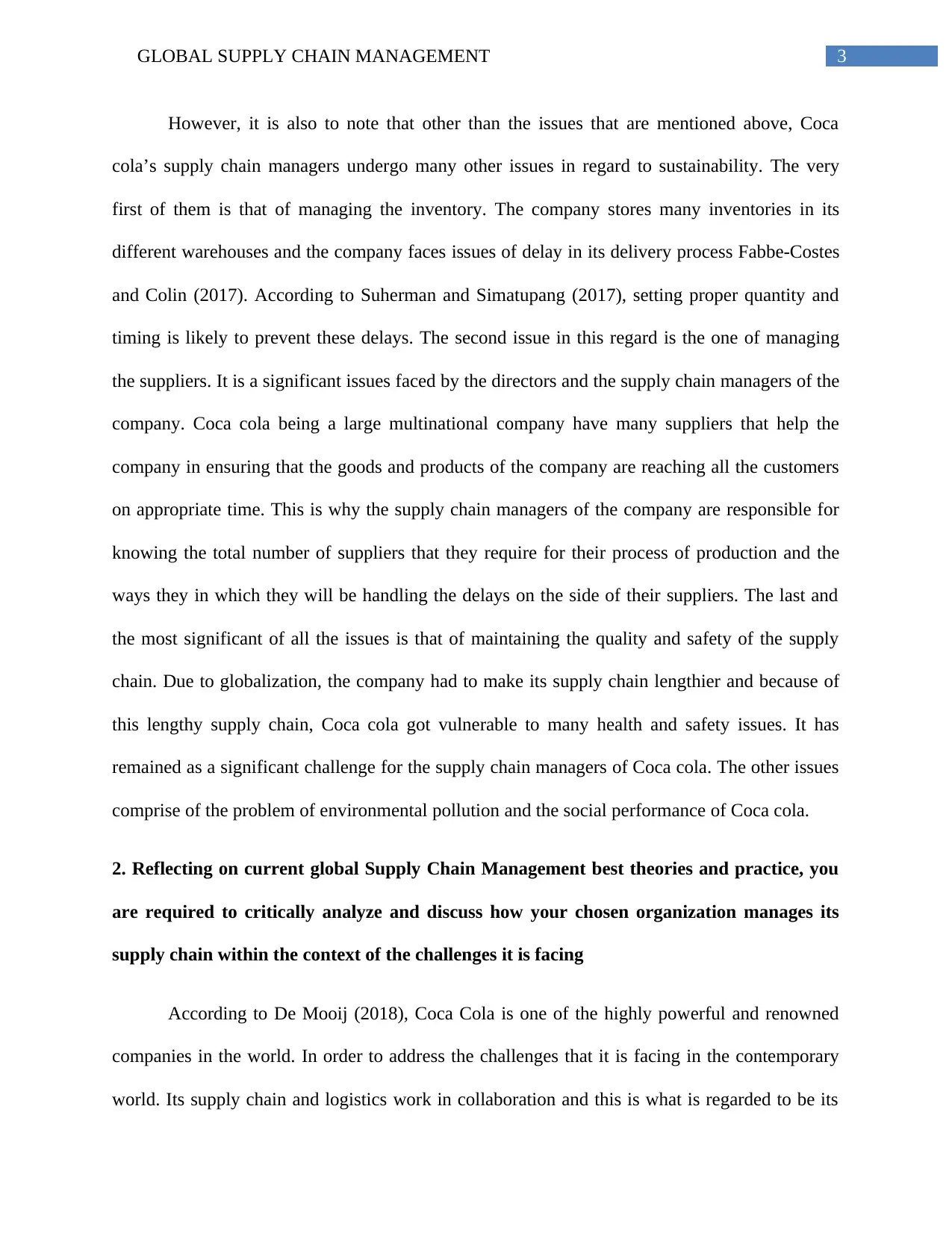
3GLOBAL SUPPLY CHAIN MANAGEMENT
However, it is also to note that other than the issues that are mentioned above, Coca
cola’s supply chain managers undergo many other issues in regard to sustainability. The very
first of them is that of managing the inventory. The company stores many inventories in its
different warehouses and the company faces issues of delay in its delivery process Fabbe-Costes
and Colin (2017). According to Suherman and Simatupang (2017), setting proper quantity and
timing is likely to prevent these delays. The second issue in this regard is the one of managing
the suppliers. It is a significant issues faced by the directors and the supply chain managers of the
company. Coca cola being a large multinational company have many suppliers that help the
company in ensuring that the goods and products of the company are reaching all the customers
on appropriate time. This is why the supply chain managers of the company are responsible for
knowing the total number of suppliers that they require for their process of production and the
ways they in which they will be handling the delays on the side of their suppliers. The last and
the most significant of all the issues is that of maintaining the quality and safety of the supply
chain. Due to globalization, the company had to make its supply chain lengthier and because of
this lengthy supply chain, Coca cola got vulnerable to many health and safety issues. It has
remained as a significant challenge for the supply chain managers of Coca cola. The other issues
comprise of the problem of environmental pollution and the social performance of Coca cola.
2. Reflecting on current global Supply Chain Management best theories and practice, you
are required to critically analyze and discuss how your chosen organization manages its
supply chain within the context of the challenges it is facing
According to De Mooij (2018), Coca Cola is one of the highly powerful and renowned
companies in the world. In order to address the challenges that it is facing in the contemporary
world. Its supply chain and logistics work in collaboration and this is what is regarded to be its
However, it is also to note that other than the issues that are mentioned above, Coca
cola’s supply chain managers undergo many other issues in regard to sustainability. The very
first of them is that of managing the inventory. The company stores many inventories in its
different warehouses and the company faces issues of delay in its delivery process Fabbe-Costes
and Colin (2017). According to Suherman and Simatupang (2017), setting proper quantity and
timing is likely to prevent these delays. The second issue in this regard is the one of managing
the suppliers. It is a significant issues faced by the directors and the supply chain managers of the
company. Coca cola being a large multinational company have many suppliers that help the
company in ensuring that the goods and products of the company are reaching all the customers
on appropriate time. This is why the supply chain managers of the company are responsible for
knowing the total number of suppliers that they require for their process of production and the
ways they in which they will be handling the delays on the side of their suppliers. The last and
the most significant of all the issues is that of maintaining the quality and safety of the supply
chain. Due to globalization, the company had to make its supply chain lengthier and because of
this lengthy supply chain, Coca cola got vulnerable to many health and safety issues. It has
remained as a significant challenge for the supply chain managers of Coca cola. The other issues
comprise of the problem of environmental pollution and the social performance of Coca cola.
2. Reflecting on current global Supply Chain Management best theories and practice, you
are required to critically analyze and discuss how your chosen organization manages its
supply chain within the context of the challenges it is facing
According to De Mooij (2018), Coca Cola is one of the highly powerful and renowned
companies in the world. In order to address the challenges that it is facing in the contemporary
world. Its supply chain and logistics work in collaboration and this is what is regarded to be its
Paraphrase This Document
Need a fresh take? Get an instant paraphrase of this document with our AI Paraphraser
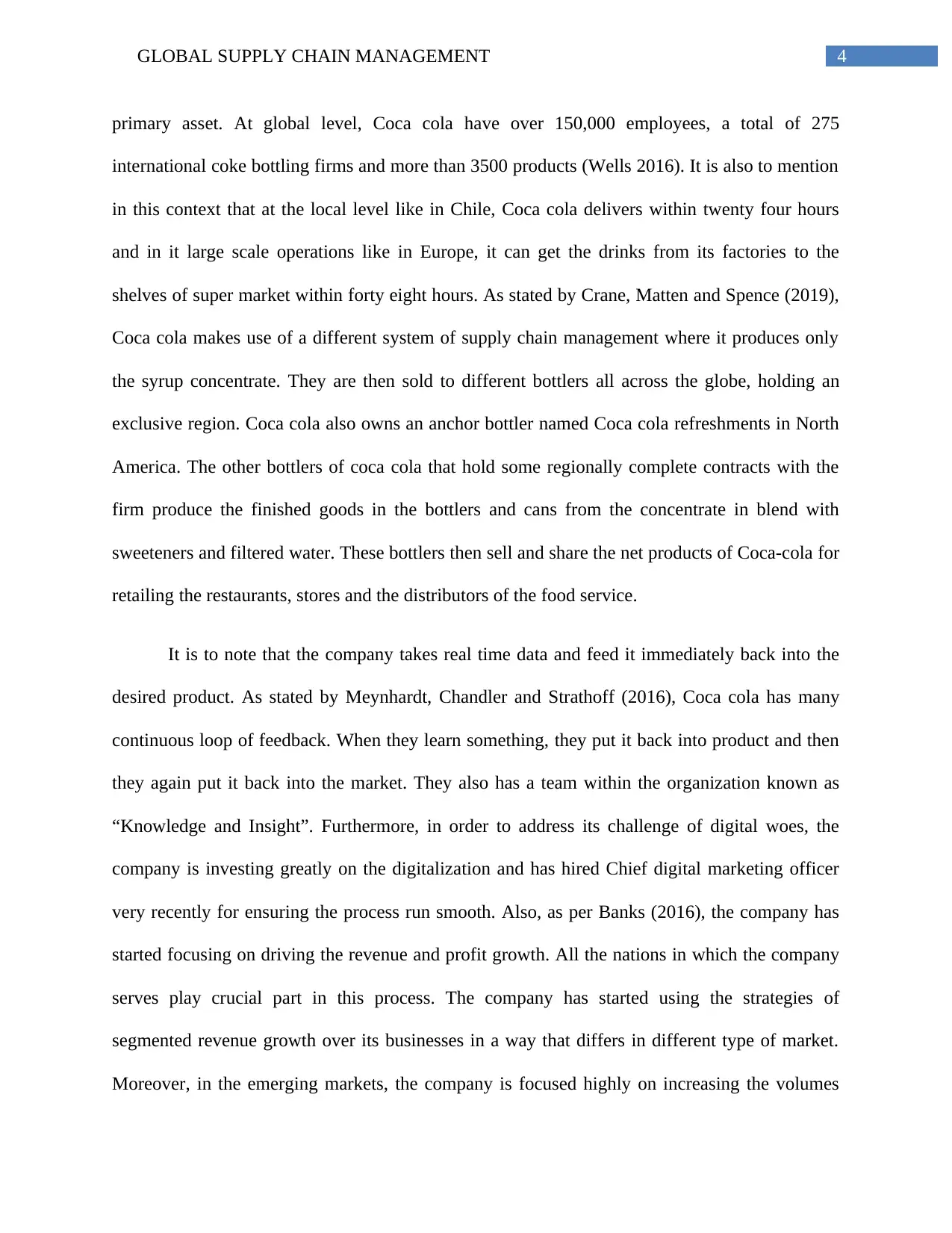
4GLOBAL SUPPLY CHAIN MANAGEMENT
primary asset. At global level, Coca cola have over 150,000 employees, a total of 275
international coke bottling firms and more than 3500 products (Wells 2016). It is also to mention
in this context that at the local level like in Chile, Coca cola delivers within twenty four hours
and in it large scale operations like in Europe, it can get the drinks from its factories to the
shelves of super market within forty eight hours. As stated by Crane, Matten and Spence (2019),
Coca cola makes use of a different system of supply chain management where it produces only
the syrup concentrate. They are then sold to different bottlers all across the globe, holding an
exclusive region. Coca cola also owns an anchor bottler named Coca cola refreshments in North
America. The other bottlers of coca cola that hold some regionally complete contracts with the
firm produce the finished goods in the bottlers and cans from the concentrate in blend with
sweeteners and filtered water. These bottlers then sell and share the net products of Coca-cola for
retailing the restaurants, stores and the distributors of the food service.
It is to note that the company takes real time data and feed it immediately back into the
desired product. As stated by Meynhardt, Chandler and Strathoff (2016), Coca cola has many
continuous loop of feedback. When they learn something, they put it back into product and then
they again put it back into the market. They also has a team within the organization known as
“Knowledge and Insight”. Furthermore, in order to address its challenge of digital woes, the
company is investing greatly on the digitalization and has hired Chief digital marketing officer
very recently for ensuring the process run smooth. Also, as per Banks (2016), the company has
started focusing on driving the revenue and profit growth. All the nations in which the company
serves play crucial part in this process. The company has started using the strategies of
segmented revenue growth over its businesses in a way that differs in different type of market.
Moreover, in the emerging markets, the company is focused highly on increasing the volumes
primary asset. At global level, Coca cola have over 150,000 employees, a total of 275
international coke bottling firms and more than 3500 products (Wells 2016). It is also to mention
in this context that at the local level like in Chile, Coca cola delivers within twenty four hours
and in it large scale operations like in Europe, it can get the drinks from its factories to the
shelves of super market within forty eight hours. As stated by Crane, Matten and Spence (2019),
Coca cola makes use of a different system of supply chain management where it produces only
the syrup concentrate. They are then sold to different bottlers all across the globe, holding an
exclusive region. Coca cola also owns an anchor bottler named Coca cola refreshments in North
America. The other bottlers of coca cola that hold some regionally complete contracts with the
firm produce the finished goods in the bottlers and cans from the concentrate in blend with
sweeteners and filtered water. These bottlers then sell and share the net products of Coca-cola for
retailing the restaurants, stores and the distributors of the food service.
It is to note that the company takes real time data and feed it immediately back into the
desired product. As stated by Meynhardt, Chandler and Strathoff (2016), Coca cola has many
continuous loop of feedback. When they learn something, they put it back into product and then
they again put it back into the market. They also has a team within the organization known as
“Knowledge and Insight”. Furthermore, in order to address its challenge of digital woes, the
company is investing greatly on the digitalization and has hired Chief digital marketing officer
very recently for ensuring the process run smooth. Also, as per Banks (2016), the company has
started focusing on driving the revenue and profit growth. All the nations in which the company
serves play crucial part in this process. The company has started using the strategies of
segmented revenue growth over its businesses in a way that differs in different type of market.
Moreover, in the emerging markets, the company is focused highly on increasing the volumes

5GLOBAL SUPPLY CHAIN MANAGEMENT
and keeping all its beverages affordable for the customers in order to strengthen the foundation
of the upcoming success. In the developing nations, Coca cola is struck for a balance in between
the pricing and volume. Also, in the developed countries, it depends highly on the product
pricing and enhancing the profitability by means of offering some small packages of its products
with premium packages like the aluminum and the glass bottles.
Furthermore, Porter and Kramer (2019) have stated that the firm has invested over its
different expensive beverage portfolio. It has enhanced its position in the energy sector along
with a strategic new partnership with the famous Monster Beverage Corporation. It has also
invested in the brands like Suja and have agreed to purchase the China Green Culiangwang a
protein beverage brand). Moreover, in the year 2015, Coca Cola have also developed its first
ever global marketing campaign for supporting the whole Coca cola trademark of Coke, the
Coke Zero, the Diet Coke and the Coca Cola life. It has launched the campaign called “Taste the
Feeling” in the early 2016 that was basically emphasized on the taste, refreshment, personal
connection and uplift of the brand and its products. With the help of this campaign, the company
is letting its customers to know that they can enjoy its products with calories, no calories, and
fewer calories and even with or without caffeine, as per their preferences. However, it is to be
noted that this choice of choosing the preferred product belongs to each and every individuals,
every time when he or she reaches for any refreshing and delicious Coca cola beverage.
It is to note that the company is widely considered to be following the relationship matrix
in its supply chain for supplying its products and services all over the world. This matrix helps in
the identification of the conditions within every categories of relationship that is highly desired.
These conditions seems to range from the lower to the higher specificity of the processes and that
of the products. It also assists in making several different assumptions for the associated risks.
and keeping all its beverages affordable for the customers in order to strengthen the foundation
of the upcoming success. In the developing nations, Coca cola is struck for a balance in between
the pricing and volume. Also, in the developed countries, it depends highly on the product
pricing and enhancing the profitability by means of offering some small packages of its products
with premium packages like the aluminum and the glass bottles.
Furthermore, Porter and Kramer (2019) have stated that the firm has invested over its
different expensive beverage portfolio. It has enhanced its position in the energy sector along
with a strategic new partnership with the famous Monster Beverage Corporation. It has also
invested in the brands like Suja and have agreed to purchase the China Green Culiangwang a
protein beverage brand). Moreover, in the year 2015, Coca Cola have also developed its first
ever global marketing campaign for supporting the whole Coca cola trademark of Coke, the
Coke Zero, the Diet Coke and the Coca Cola life. It has launched the campaign called “Taste the
Feeling” in the early 2016 that was basically emphasized on the taste, refreshment, personal
connection and uplift of the brand and its products. With the help of this campaign, the company
is letting its customers to know that they can enjoy its products with calories, no calories, and
fewer calories and even with or without caffeine, as per their preferences. However, it is to be
noted that this choice of choosing the preferred product belongs to each and every individuals,
every time when he or she reaches for any refreshing and delicious Coca cola beverage.
It is to note that the company is widely considered to be following the relationship matrix
in its supply chain for supplying its products and services all over the world. This matrix helps in
the identification of the conditions within every categories of relationship that is highly desired.
These conditions seems to range from the lower to the higher specificity of the processes and that
of the products. It also assists in making several different assumptions for the associated risks.
⊘ This is a preview!⊘
Do you want full access?
Subscribe today to unlock all pages.

Trusted by 1+ million students worldwide
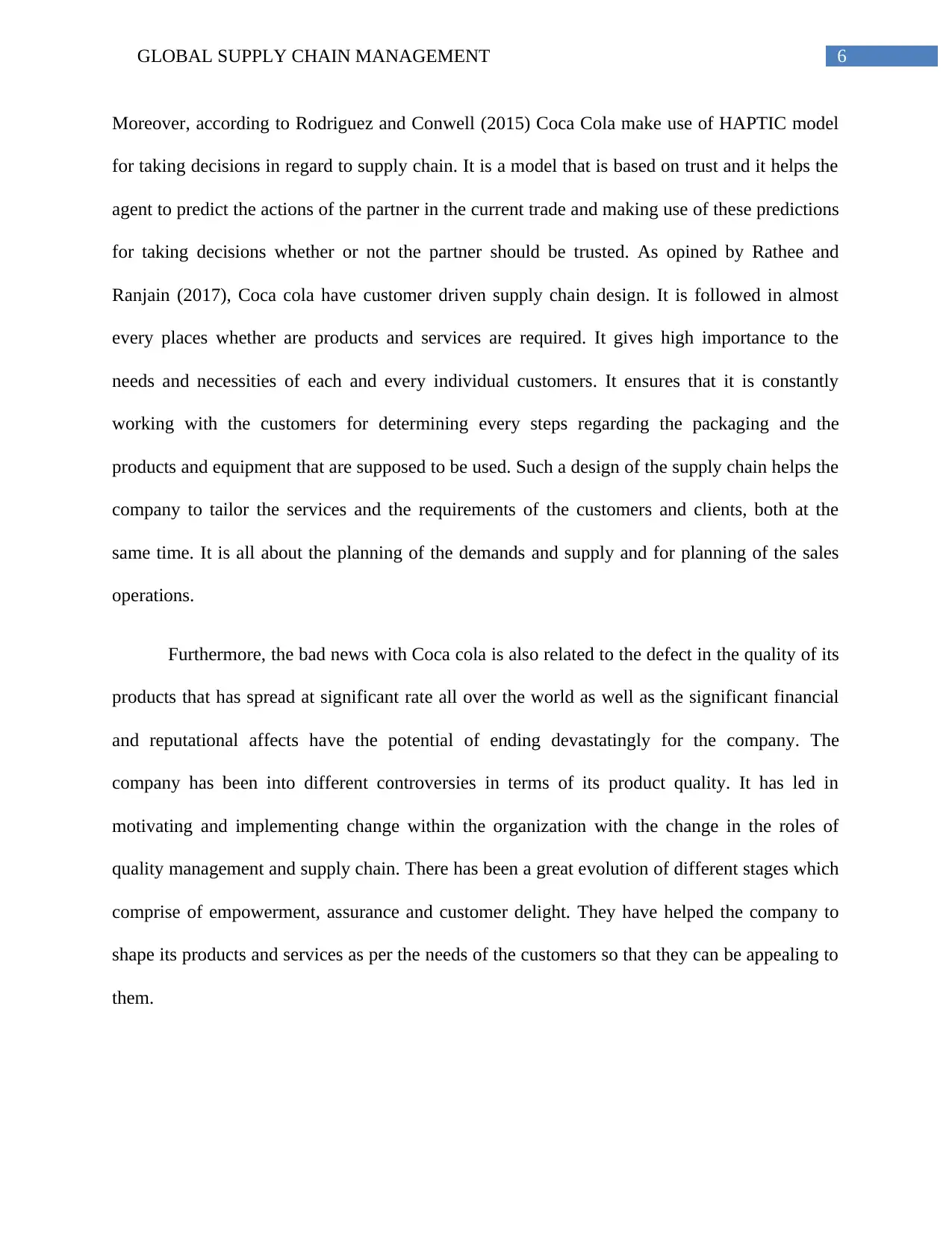
6GLOBAL SUPPLY CHAIN MANAGEMENT
Moreover, according to Rodriguez and Conwell (2015) Coca Cola make use of HAPTIC model
for taking decisions in regard to supply chain. It is a model that is based on trust and it helps the
agent to predict the actions of the partner in the current trade and making use of these predictions
for taking decisions whether or not the partner should be trusted. As opined by Rathee and
Ranjain (2017), Coca cola have customer driven supply chain design. It is followed in almost
every places whether are products and services are required. It gives high importance to the
needs and necessities of each and every individual customers. It ensures that it is constantly
working with the customers for determining every steps regarding the packaging and the
products and equipment that are supposed to be used. Such a design of the supply chain helps the
company to tailor the services and the requirements of the customers and clients, both at the
same time. It is all about the planning of the demands and supply and for planning of the sales
operations.
Furthermore, the bad news with Coca cola is also related to the defect in the quality of its
products that has spread at significant rate all over the world as well as the significant financial
and reputational affects have the potential of ending devastatingly for the company. The
company has been into different controversies in terms of its product quality. It has led in
motivating and implementing change within the organization with the change in the roles of
quality management and supply chain. There has been a great evolution of different stages which
comprise of empowerment, assurance and customer delight. They have helped the company to
shape its products and services as per the needs of the customers so that they can be appealing to
them.
Moreover, according to Rodriguez and Conwell (2015) Coca Cola make use of HAPTIC model
for taking decisions in regard to supply chain. It is a model that is based on trust and it helps the
agent to predict the actions of the partner in the current trade and making use of these predictions
for taking decisions whether or not the partner should be trusted. As opined by Rathee and
Ranjain (2017), Coca cola have customer driven supply chain design. It is followed in almost
every places whether are products and services are required. It gives high importance to the
needs and necessities of each and every individual customers. It ensures that it is constantly
working with the customers for determining every steps regarding the packaging and the
products and equipment that are supposed to be used. Such a design of the supply chain helps the
company to tailor the services and the requirements of the customers and clients, both at the
same time. It is all about the planning of the demands and supply and for planning of the sales
operations.
Furthermore, the bad news with Coca cola is also related to the defect in the quality of its
products that has spread at significant rate all over the world as well as the significant financial
and reputational affects have the potential of ending devastatingly for the company. The
company has been into different controversies in terms of its product quality. It has led in
motivating and implementing change within the organization with the change in the roles of
quality management and supply chain. There has been a great evolution of different stages which
comprise of empowerment, assurance and customer delight. They have helped the company to
shape its products and services as per the needs of the customers so that they can be appealing to
them.
Paraphrase This Document
Need a fresh take? Get an instant paraphrase of this document with our AI Paraphraser
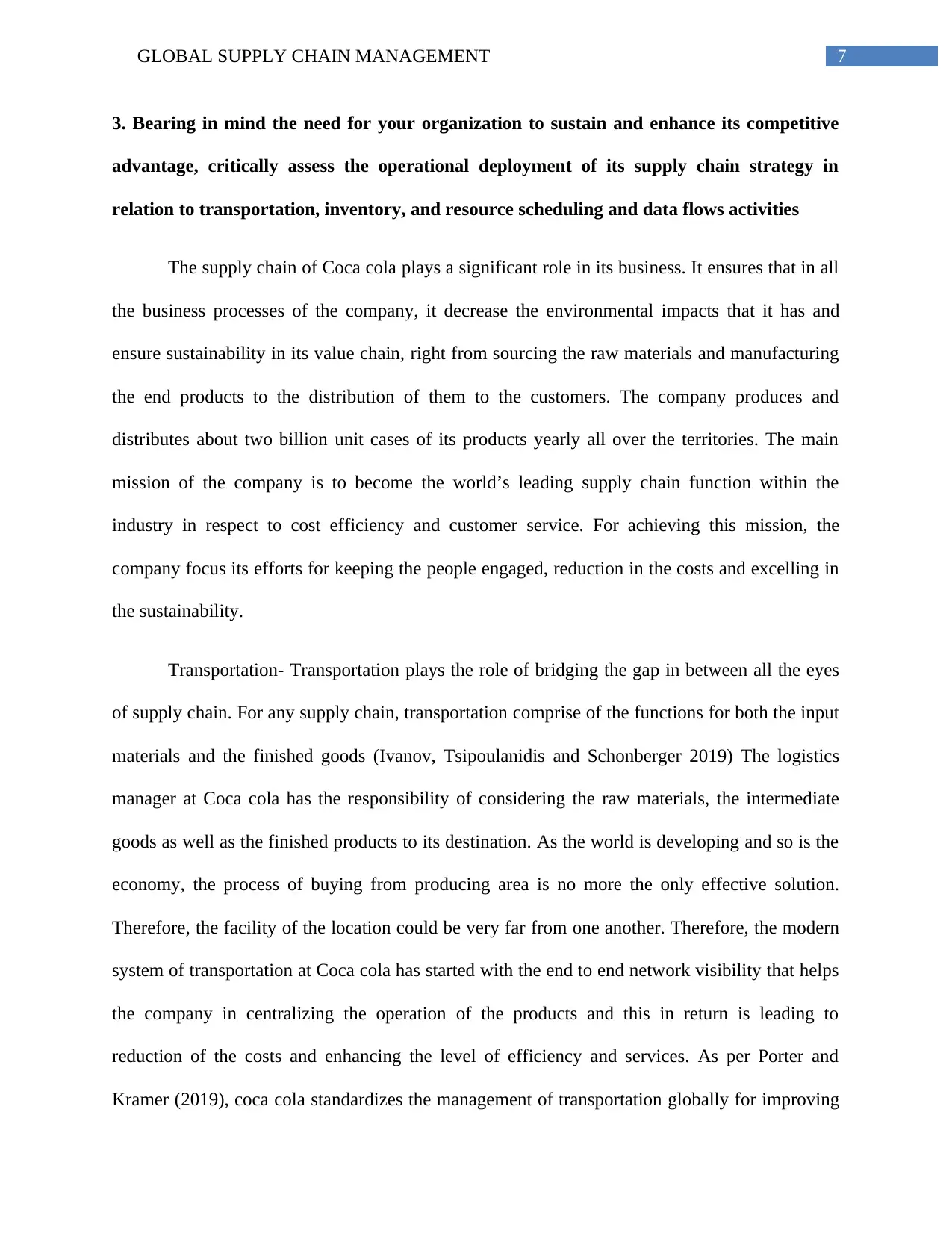
7GLOBAL SUPPLY CHAIN MANAGEMENT
3. Bearing in mind the need for your organization to sustain and enhance its competitive
advantage, critically assess the operational deployment of its supply chain strategy in
relation to transportation, inventory, and resource scheduling and data flows activities
The supply chain of Coca cola plays a significant role in its business. It ensures that in all
the business processes of the company, it decrease the environmental impacts that it has and
ensure sustainability in its value chain, right from sourcing the raw materials and manufacturing
the end products to the distribution of them to the customers. The company produces and
distributes about two billion unit cases of its products yearly all over the territories. The main
mission of the company is to become the world’s leading supply chain function within the
industry in respect to cost efficiency and customer service. For achieving this mission, the
company focus its efforts for keeping the people engaged, reduction in the costs and excelling in
the sustainability.
Transportation- Transportation plays the role of bridging the gap in between all the eyes
of supply chain. For any supply chain, transportation comprise of the functions for both the input
materials and the finished goods (Ivanov, Tsipoulanidis and Schonberger 2019) The logistics
manager at Coca cola has the responsibility of considering the raw materials, the intermediate
goods as well as the finished products to its destination. As the world is developing and so is the
economy, the process of buying from producing area is no more the only effective solution.
Therefore, the facility of the location could be very far from one another. Therefore, the modern
system of transportation at Coca cola has started with the end to end network visibility that helps
the company in centralizing the operation of the products and this in return is leading to
reduction of the costs and enhancing the level of efficiency and services. As per Porter and
Kramer (2019), coca cola standardizes the management of transportation globally for improving
3. Bearing in mind the need for your organization to sustain and enhance its competitive
advantage, critically assess the operational deployment of its supply chain strategy in
relation to transportation, inventory, and resource scheduling and data flows activities
The supply chain of Coca cola plays a significant role in its business. It ensures that in all
the business processes of the company, it decrease the environmental impacts that it has and
ensure sustainability in its value chain, right from sourcing the raw materials and manufacturing
the end products to the distribution of them to the customers. The company produces and
distributes about two billion unit cases of its products yearly all over the territories. The main
mission of the company is to become the world’s leading supply chain function within the
industry in respect to cost efficiency and customer service. For achieving this mission, the
company focus its efforts for keeping the people engaged, reduction in the costs and excelling in
the sustainability.
Transportation- Transportation plays the role of bridging the gap in between all the eyes
of supply chain. For any supply chain, transportation comprise of the functions for both the input
materials and the finished goods (Ivanov, Tsipoulanidis and Schonberger 2019) The logistics
manager at Coca cola has the responsibility of considering the raw materials, the intermediate
goods as well as the finished products to its destination. As the world is developing and so is the
economy, the process of buying from producing area is no more the only effective solution.
Therefore, the facility of the location could be very far from one another. Therefore, the modern
system of transportation at Coca cola has started with the end to end network visibility that helps
the company in centralizing the operation of the products and this in return is leading to
reduction of the costs and enhancing the level of efficiency and services. As per Porter and
Kramer (2019), coca cola standardizes the management of transportation globally for improving

8GLOBAL SUPPLY CHAIN MANAGEMENT
the freight status visibility and efficiency along with reducing the costs. The transportation
department of Coca cola distribute its products with right product in right quantity, at right place
and that too, with right quality and price. It is to note that Coca cola make use of highways for
transporting its product all over the land (Rathee and Rajain 2017). With the same, it makes use
of international airports for transporting goods to the other nations in the world and make use of
deep water ports for shipping the cargo to the other nations world-wide.
Inventory- It is to mention that the inventories comprise basically of the raw materials,
packaging and the finished goods. The packaging and raw materials of Coca cola include the
supplies and ingredients and the finished goods of the company comprise of the syrups and
concentrates in the concentrate operations of Coca cola along with the finished beverages in the
finished product operations. The inventories of the company are valued at lower cost (Li and Li
2017). The company determined its product cost depending on the average cost or by the first in
first out process. It has also implemented QAD Advanced Inventory Management solution for
enhancing its deployment of its supply chain management. It is to note that QAD is an enterprise
solution provider for the global manufacturer. It also use AIM for helping in optimizing the
warehouse operations at the Switzerland plants by means of determining the processes of
warehousing and the physical aspects of the stock management which can be used for
streamlining greater efficiency (Scott, Lundgren and Thompson 2018). It provides the company
real time management of the warehouse operations of the company and help it in extending the
traditional capabilities of the inventory management and at the same time, helps it in increasing
the supply chain responsiveness.
Resource Scheduling- The Puerto Rico Bottlers of Coca cola is deploying one of the
integrated suite of the company and its supply chain solutions at a total of three different
the freight status visibility and efficiency along with reducing the costs. The transportation
department of Coca cola distribute its products with right product in right quantity, at right place
and that too, with right quality and price. It is to note that Coca cola make use of highways for
transporting its product all over the land (Rathee and Rajain 2017). With the same, it makes use
of international airports for transporting goods to the other nations in the world and make use of
deep water ports for shipping the cargo to the other nations world-wide.
Inventory- It is to mention that the inventories comprise basically of the raw materials,
packaging and the finished goods. The packaging and raw materials of Coca cola include the
supplies and ingredients and the finished goods of the company comprise of the syrups and
concentrates in the concentrate operations of Coca cola along with the finished beverages in the
finished product operations. The inventories of the company are valued at lower cost (Li and Li
2017). The company determined its product cost depending on the average cost or by the first in
first out process. It has also implemented QAD Advanced Inventory Management solution for
enhancing its deployment of its supply chain management. It is to note that QAD is an enterprise
solution provider for the global manufacturer. It also use AIM for helping in optimizing the
warehouse operations at the Switzerland plants by means of determining the processes of
warehousing and the physical aspects of the stock management which can be used for
streamlining greater efficiency (Scott, Lundgren and Thompson 2018). It provides the company
real time management of the warehouse operations of the company and help it in extending the
traditional capabilities of the inventory management and at the same time, helps it in increasing
the supply chain responsiveness.
Resource Scheduling- The Puerto Rico Bottlers of Coca cola is deploying one of the
integrated suite of the company and its supply chain solutions at a total of three different
⊘ This is a preview!⊘
Do you want full access?
Subscribe today to unlock all pages.

Trusted by 1+ million students worldwide
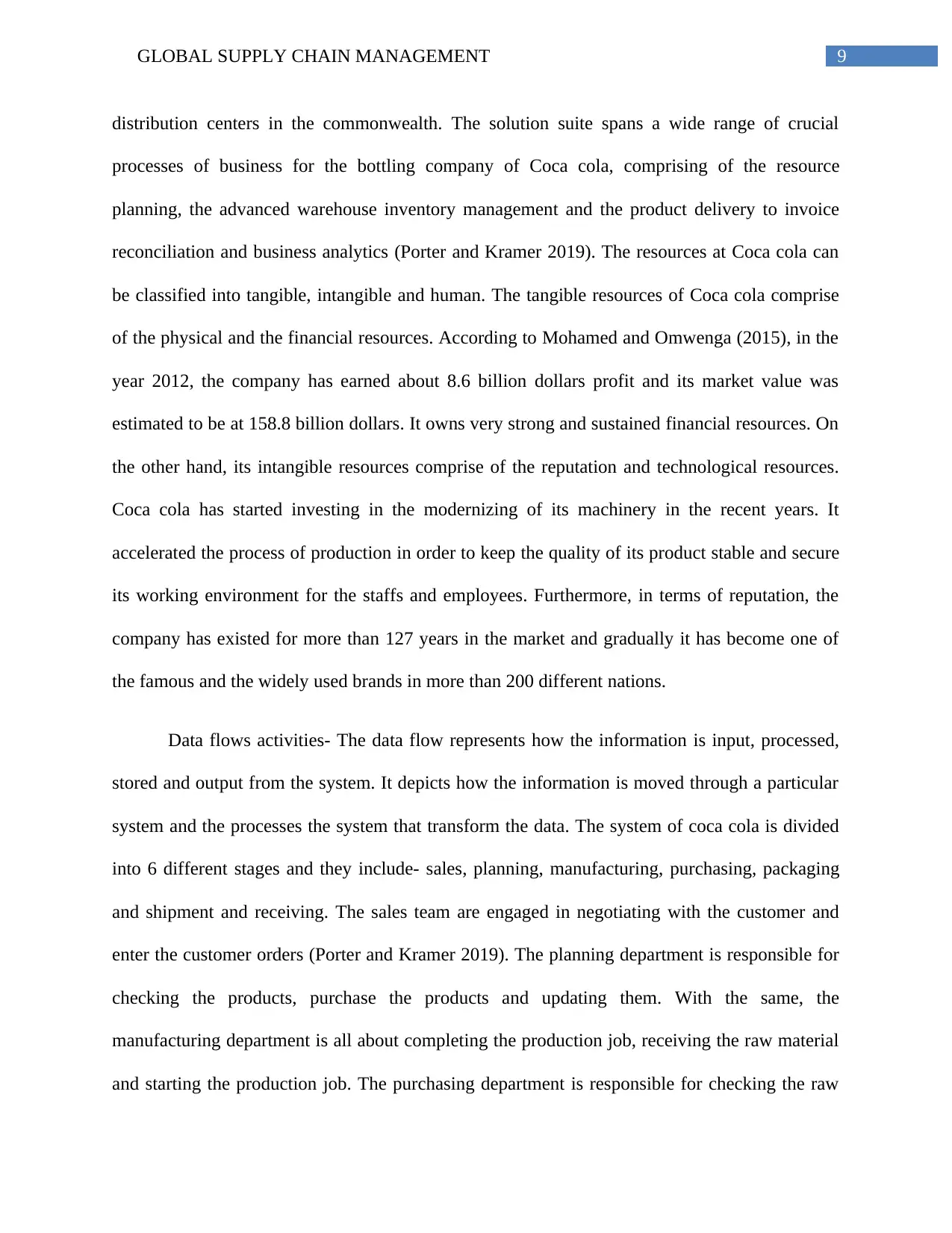
9GLOBAL SUPPLY CHAIN MANAGEMENT
distribution centers in the commonwealth. The solution suite spans a wide range of crucial
processes of business for the bottling company of Coca cola, comprising of the resource
planning, the advanced warehouse inventory management and the product delivery to invoice
reconciliation and business analytics (Porter and Kramer 2019). The resources at Coca cola can
be classified into tangible, intangible and human. The tangible resources of Coca cola comprise
of the physical and the financial resources. According to Mohamed and Omwenga (2015), in the
year 2012, the company has earned about 8.6 billion dollars profit and its market value was
estimated to be at 158.8 billion dollars. It owns very strong and sustained financial resources. On
the other hand, its intangible resources comprise of the reputation and technological resources.
Coca cola has started investing in the modernizing of its machinery in the recent years. It
accelerated the process of production in order to keep the quality of its product stable and secure
its working environment for the staffs and employees. Furthermore, in terms of reputation, the
company has existed for more than 127 years in the market and gradually it has become one of
the famous and the widely used brands in more than 200 different nations.
Data flows activities- The data flow represents how the information is input, processed,
stored and output from the system. It depicts how the information is moved through a particular
system and the processes the system that transform the data. The system of coca cola is divided
into 6 different stages and they include- sales, planning, manufacturing, purchasing, packaging
and shipment and receiving. The sales team are engaged in negotiating with the customer and
enter the customer orders (Porter and Kramer 2019). The planning department is responsible for
checking the products, purchase the products and updating them. With the same, the
manufacturing department is all about completing the production job, receiving the raw material
and starting the production job. The purchasing department is responsible for checking the raw
distribution centers in the commonwealth. The solution suite spans a wide range of crucial
processes of business for the bottling company of Coca cola, comprising of the resource
planning, the advanced warehouse inventory management and the product delivery to invoice
reconciliation and business analytics (Porter and Kramer 2019). The resources at Coca cola can
be classified into tangible, intangible and human. The tangible resources of Coca cola comprise
of the physical and the financial resources. According to Mohamed and Omwenga (2015), in the
year 2012, the company has earned about 8.6 billion dollars profit and its market value was
estimated to be at 158.8 billion dollars. It owns very strong and sustained financial resources. On
the other hand, its intangible resources comprise of the reputation and technological resources.
Coca cola has started investing in the modernizing of its machinery in the recent years. It
accelerated the process of production in order to keep the quality of its product stable and secure
its working environment for the staffs and employees. Furthermore, in terms of reputation, the
company has existed for more than 127 years in the market and gradually it has become one of
the famous and the widely used brands in more than 200 different nations.
Data flows activities- The data flow represents how the information is input, processed,
stored and output from the system. It depicts how the information is moved through a particular
system and the processes the system that transform the data. The system of coca cola is divided
into 6 different stages and they include- sales, planning, manufacturing, purchasing, packaging
and shipment and receiving. The sales team are engaged in negotiating with the customer and
enter the customer orders (Porter and Kramer 2019). The planning department is responsible for
checking the products, purchase the products and updating them. With the same, the
manufacturing department is all about completing the production job, receiving the raw material
and starting the production job. The purchasing department is responsible for checking the raw
Paraphrase This Document
Need a fresh take? Get an instant paraphrase of this document with our AI Paraphraser
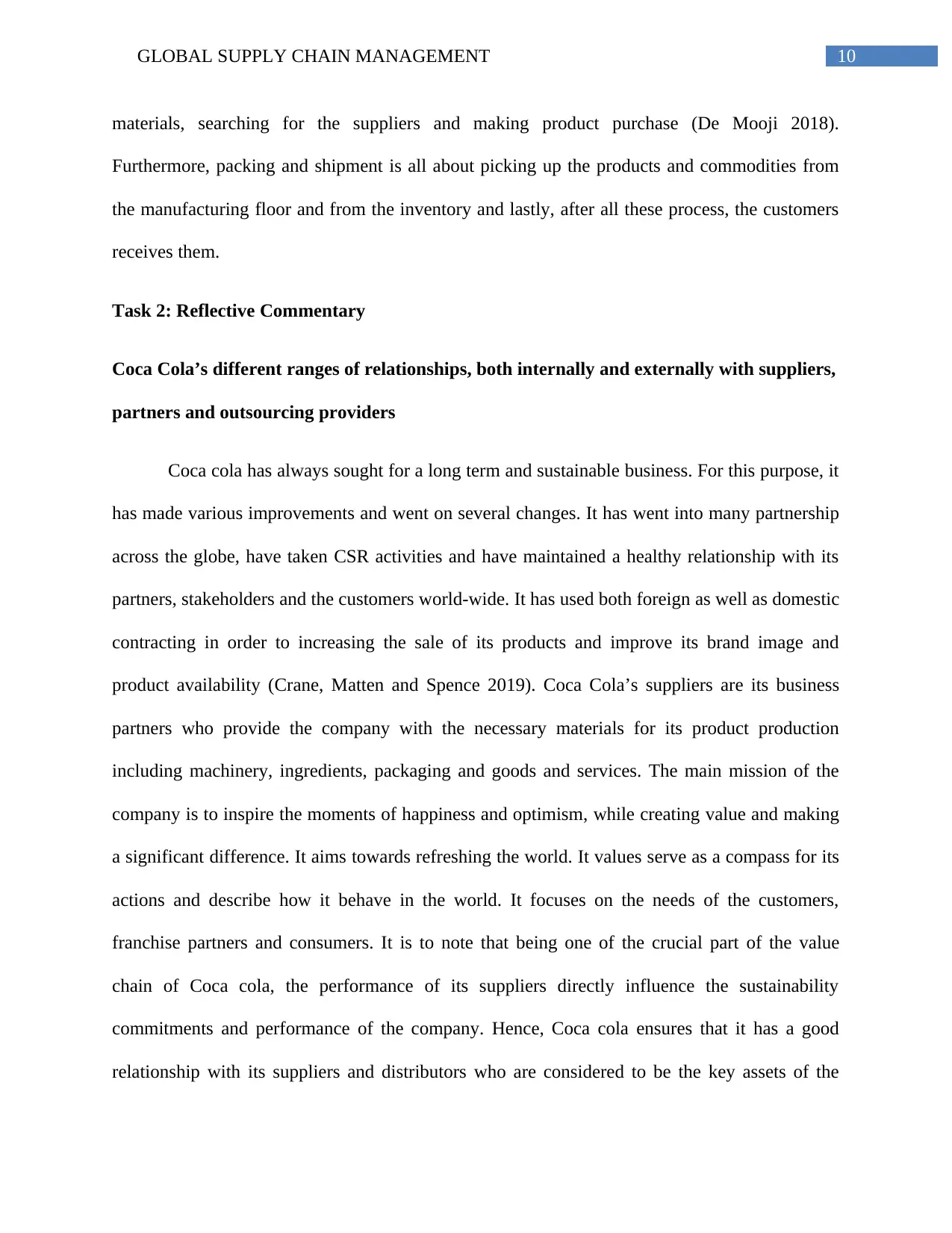
10GLOBAL SUPPLY CHAIN MANAGEMENT
materials, searching for the suppliers and making product purchase (De Mooji 2018).
Furthermore, packing and shipment is all about picking up the products and commodities from
the manufacturing floor and from the inventory and lastly, after all these process, the customers
receives them.
Task 2: Reflective Commentary
Coca Cola’s different ranges of relationships, both internally and externally with suppliers,
partners and outsourcing providers
Coca cola has always sought for a long term and sustainable business. For this purpose, it
has made various improvements and went on several changes. It has went into many partnership
across the globe, have taken CSR activities and have maintained a healthy relationship with its
partners, stakeholders and the customers world-wide. It has used both foreign as well as domestic
contracting in order to increasing the sale of its products and improve its brand image and
product availability (Crane, Matten and Spence 2019). Coca Cola’s suppliers are its business
partners who provide the company with the necessary materials for its product production
including machinery, ingredients, packaging and goods and services. The main mission of the
company is to inspire the moments of happiness and optimism, while creating value and making
a significant difference. It aims towards refreshing the world. It values serve as a compass for its
actions and describe how it behave in the world. It focuses on the needs of the customers,
franchise partners and consumers. It is to note that being one of the crucial part of the value
chain of Coca cola, the performance of its suppliers directly influence the sustainability
commitments and performance of the company. Hence, Coca cola ensures that it has a good
relationship with its suppliers and distributors who are considered to be the key assets of the
materials, searching for the suppliers and making product purchase (De Mooji 2018).
Furthermore, packing and shipment is all about picking up the products and commodities from
the manufacturing floor and from the inventory and lastly, after all these process, the customers
receives them.
Task 2: Reflective Commentary
Coca Cola’s different ranges of relationships, both internally and externally with suppliers,
partners and outsourcing providers
Coca cola has always sought for a long term and sustainable business. For this purpose, it
has made various improvements and went on several changes. It has went into many partnership
across the globe, have taken CSR activities and have maintained a healthy relationship with its
partners, stakeholders and the customers world-wide. It has used both foreign as well as domestic
contracting in order to increasing the sale of its products and improve its brand image and
product availability (Crane, Matten and Spence 2019). Coca Cola’s suppliers are its business
partners who provide the company with the necessary materials for its product production
including machinery, ingredients, packaging and goods and services. The main mission of the
company is to inspire the moments of happiness and optimism, while creating value and making
a significant difference. It aims towards refreshing the world. It values serve as a compass for its
actions and describe how it behave in the world. It focuses on the needs of the customers,
franchise partners and consumers. It is to note that being one of the crucial part of the value
chain of Coca cola, the performance of its suppliers directly influence the sustainability
commitments and performance of the company. Hence, Coca cola ensures that it has a good
relationship with its suppliers and distributors who are considered to be the key assets of the
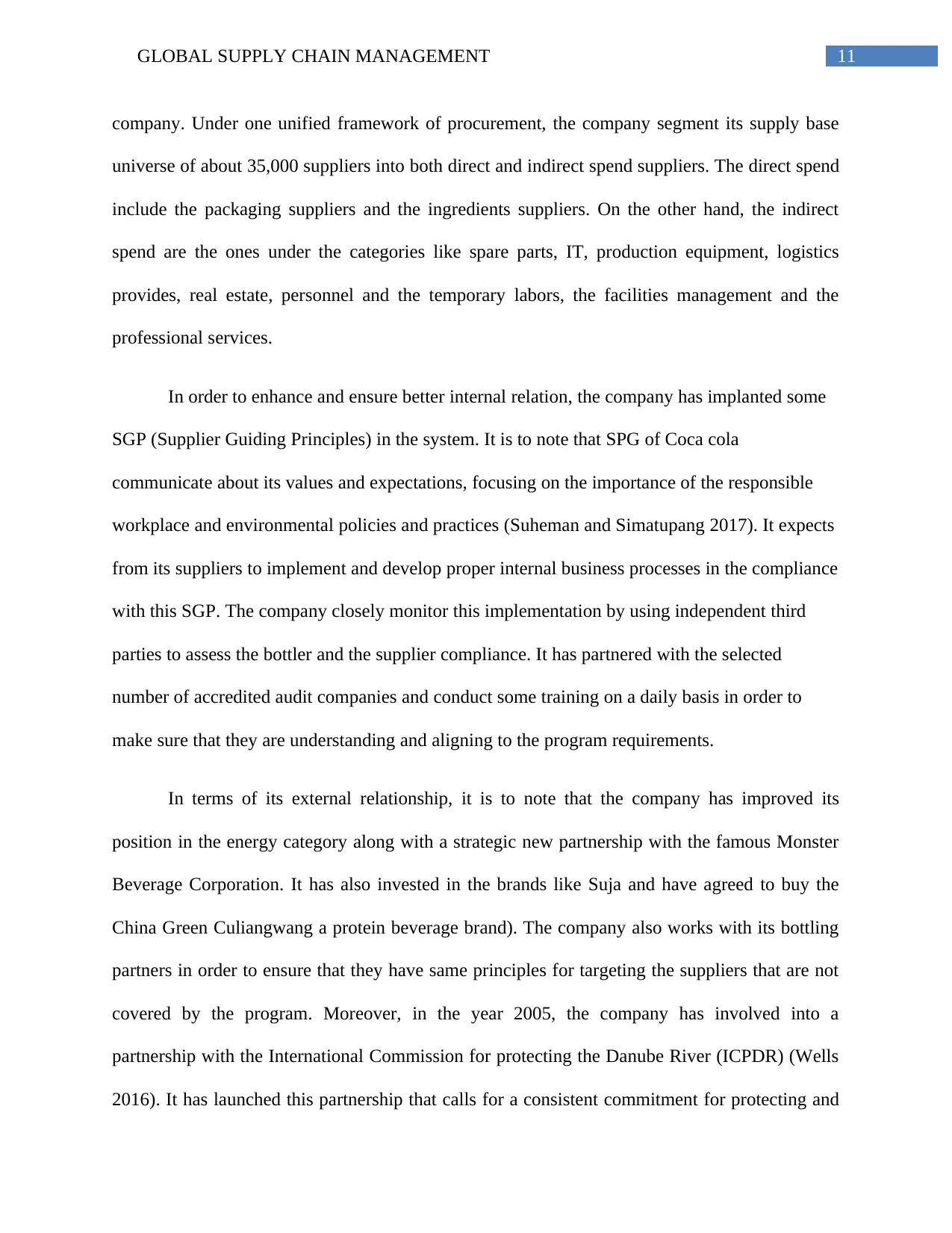
11GLOBAL SUPPLY CHAIN MANAGEMENT
company. Under one unified framework of procurement, the company segment its supply base
universe of about 35,000 suppliers into both direct and indirect spend suppliers. The direct spend
include the packaging suppliers and the ingredients suppliers. On the other hand, the indirect
spend are the ones under the categories like spare parts, IT, production equipment, logistics
provides, real estate, personnel and the temporary labors, the facilities management and the
professional services.
In order to enhance and ensure better internal relation, the company has implanted some
SGP (Supplier Guiding Principles) in the system. It is to note that SPG of Coca cola
communicate about its values and expectations, focusing on the importance of the responsible
workplace and environmental policies and practices (Suheman and Simatupang 2017). It expects
from its suppliers to implement and develop proper internal business processes in the compliance
with this SGP. The company closely monitor this implementation by using independent third
parties to assess the bottler and the supplier compliance. It has partnered with the selected
number of accredited audit companies and conduct some training on a daily basis in order to
make sure that they are understanding and aligning to the program requirements.
In terms of its external relationship, it is to note that the company has improved its
position in the energy category along with a strategic new partnership with the famous Monster
Beverage Corporation. It has also invested in the brands like Suja and have agreed to buy the
China Green Culiangwang a protein beverage brand). The company also works with its bottling
partners in order to ensure that they have same principles for targeting the suppliers that are not
covered by the program. Moreover, in the year 2005, the company has involved into a
partnership with the International Commission for protecting the Danube River (ICPDR) (Wells
2016). It has launched this partnership that calls for a consistent commitment for protecting and
company. Under one unified framework of procurement, the company segment its supply base
universe of about 35,000 suppliers into both direct and indirect spend suppliers. The direct spend
include the packaging suppliers and the ingredients suppliers. On the other hand, the indirect
spend are the ones under the categories like spare parts, IT, production equipment, logistics
provides, real estate, personnel and the temporary labors, the facilities management and the
professional services.
In order to enhance and ensure better internal relation, the company has implanted some
SGP (Supplier Guiding Principles) in the system. It is to note that SPG of Coca cola
communicate about its values and expectations, focusing on the importance of the responsible
workplace and environmental policies and practices (Suheman and Simatupang 2017). It expects
from its suppliers to implement and develop proper internal business processes in the compliance
with this SGP. The company closely monitor this implementation by using independent third
parties to assess the bottler and the supplier compliance. It has partnered with the selected
number of accredited audit companies and conduct some training on a daily basis in order to
make sure that they are understanding and aligning to the program requirements.
In terms of its external relationship, it is to note that the company has improved its
position in the energy category along with a strategic new partnership with the famous Monster
Beverage Corporation. It has also invested in the brands like Suja and have agreed to buy the
China Green Culiangwang a protein beverage brand). The company also works with its bottling
partners in order to ensure that they have same principles for targeting the suppliers that are not
covered by the program. Moreover, in the year 2005, the company has involved into a
partnership with the International Commission for protecting the Danube River (ICPDR) (Wells
2016). It has launched this partnership that calls for a consistent commitment for protecting and
⊘ This is a preview!⊘
Do you want full access?
Subscribe today to unlock all pages.

Trusted by 1+ million students worldwide
1 out of 17
Related Documents
Your All-in-One AI-Powered Toolkit for Academic Success.
+13062052269
info@desklib.com
Available 24*7 on WhatsApp / Email
![[object Object]](/_next/static/media/star-bottom.7253800d.svg)
Unlock your academic potential
Copyright © 2020–2025 A2Z Services. All Rights Reserved. Developed and managed by ZUCOL.





